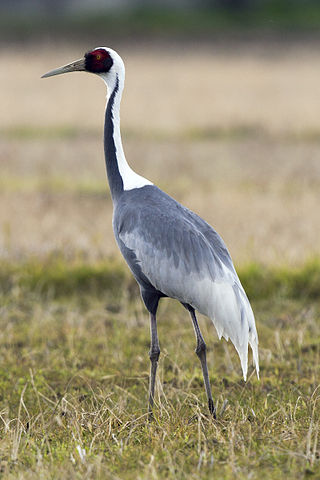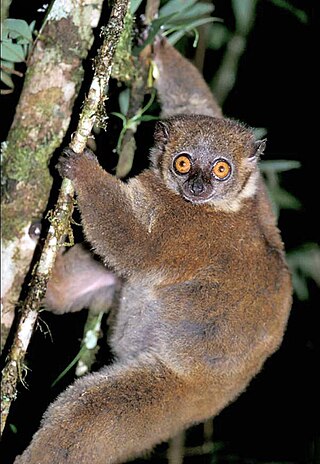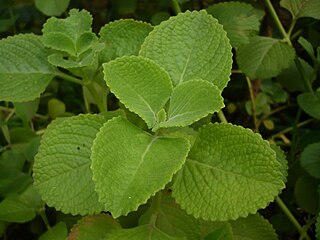
The Lamiaceae or Labiatae are a family of flowering plants commonly known as the mint, deadnettle or sage family. Many of the plants are aromatic in all parts and include widely used culinary herbs like basil, mint, rosemary, sage, savory, marjoram, oregano, hyssop, thyme, lavender, and perilla, as well as other medicinal herbs such as catnip, salvia, bee balm, wild dagga, and oriental motherwort. Some species are shrubs, trees, or, rarely, vines. Many members of the family are widely cultivated, not only for their aromatic qualities, but also their ease of cultivation, since they are readily propagated by stem cuttings. Besides those grown for their edible leaves, some are grown for decorative foliage. Others are grown for seed, such as Salvia hispanica (chia), or for their edible tubers, such as Plectranthus edulis, Plectranthus esculentus, Plectranthus rotundifolius, and Stachys affinis. Many are also grown ornamentally, notably coleus, Plectranthus, and many Salvia species and hybrids.

The white-naped crane is a bird of the crane family. It is a large bird, 112–125 cm (44–49 in) long, about 130 cm (4.3 ft) tall, and weighing about 5.6 kg (12 lb), with pinkish legs, a grey-and-white-striped neck, and a red face patch.

Plectranthus is a genus of about 85 species of flowering plants from the sage family, Lamiaceae, found mostly in southern and tropical Africa and Madagascar. Common names include spur-flower. Plectranthus species are herbaceous perennial plants, rarely annuals or soft-wooded shrubs, sometimes succulent; sometimes with a tuberous base.

Coleus scutellarioides, commonly known as coleus, is a species of flowering plant in the family Lamiaceae, native to southeast Asia through to Australia. Typically growing to 60–75 cm (24–30 in) tall and wide, it is a bushy, woody-based evergreen perennial, widely grown for the highly decorative variegated leaves found in cultivated varieties. Another common name is painted nettle, reflecting its relationship to deadnettles, which are in the same family. The synonyms Coleus blumei, Plectranthus scutellarioides and Solenostemon scutellarioides are also widely used for this species.
Coleus cataractarum, synonym Plectranthus cataractarum, is a species of flowering plant in the family Lamiaceae. It is found in Cameroon and Equatorial Guinea. Its natural habitats are subtropical or tropical moist lowland forests and rivers, near waterfalls. It is threatened by habitat loss.
Coleus dissitiflorus, synonym Plectranthus dissitiflorus, is a species of flowering plant in the family Lamiaceae. It is found only in Cameroon. Its natural habitat is subtropical or tropical dry forests. C. dissitiflorus is threatened by habitat loss.
Coleus socotranus, synonym Plectranthus socotranus, is a species of flowering plant in the family Lamiaceae.
Coleus unguentarius, synonym Plectranthus unguentarius, is a species of flowering plant in the family Lamiaceae. It is found only in Namibia. Its natural habitat is rocky areas. It is threatened by habitat loss.

The small-toothed sportive lemur, or small-toothed weasel lemur, is a primate species in the family Lepilemuridae that—like all extant lemurs—is endemic to Madagascar. The species lives in dense rainforest in southeastern Madagascar, and can be found in Ranomafana and Andringitra National Parks. Described in 1894, it was considered either a subspecies or taxonomic synonym of the weasel sportive lemur throughout most of the 20th century. Phylogenetic studies not only support its species status, but also suggest that it is the only eastern Malagasy sportive lemur that is more closely related to western than to other eastern species.

Oxera is a genus of flowering plants in the family Lamiaceae native to Vanuatu and New Caledonia in the western Pacific.

The southern woolly lemur, or southern avahi, has been recently recognized as a separate species of woolly lemur in 2006 by Zaramody et al. It is a nocturnal and pair-living species. Groups can range from 2 to 5 individuals. A study in Sainte Luce forest revealed home range varied from 2.2 to 3.5 ha and that males can have larger home range and cover longer daily distances than females, in agreement with the territory defence and mate guarding hypotheses.

Plethodontohyla alluaudi is a frog belonging to the Madagascar-endemic subfamily Cophylinae of the family Microhylidae. It is endemic to southeastern Madagascar. It is a terrestrial and fossorial frog that occurs in rainforest, including littoral forest. Despite being locally abundant, it is a difficult frog to find.

Coleus is a genus of annual or perennial herbs or shrubs, sometimes succulent, sometimes with a fleshy or tuberous rootstock, found in the Afro-Eurasia tropics and subtropics.

Capitanopsis is a genus of plants in the family Lamiaceae, first described in 1916. It contains six known species, all endemic to Madagascar.

Coleus fredericii, synonym Plectranthus welwitschii, is a species of plant in the family Lamiaceae. The epithet is also spelt frederici.

Nepetoideae is a subfamily of plants in the family Lamiaceae.
Equilabium is a genus of flowering plants in the family Lamiaceae. It was split off from the genus Plectranthus in 2018 as the result of a molecular phylogenetic study. Most species are native to Africa, with two found in the Indian subcontinent.
Coleus maculosus is a species of flowering plant in the family Lamiaceae. It is widespread in tropical Africa and Madagascar.
Capitanopsis magentea is a species of flowering plant in the family Lamiaceae. It is native to northern Madagascar.
Capitanopsis oreophila, synonym Plectranthus bipinnatus, is a species of flowering plant in the family Lamiaceae. It is a small shrub native to Madagascar, where it is commonly known as andriamborondrao.













